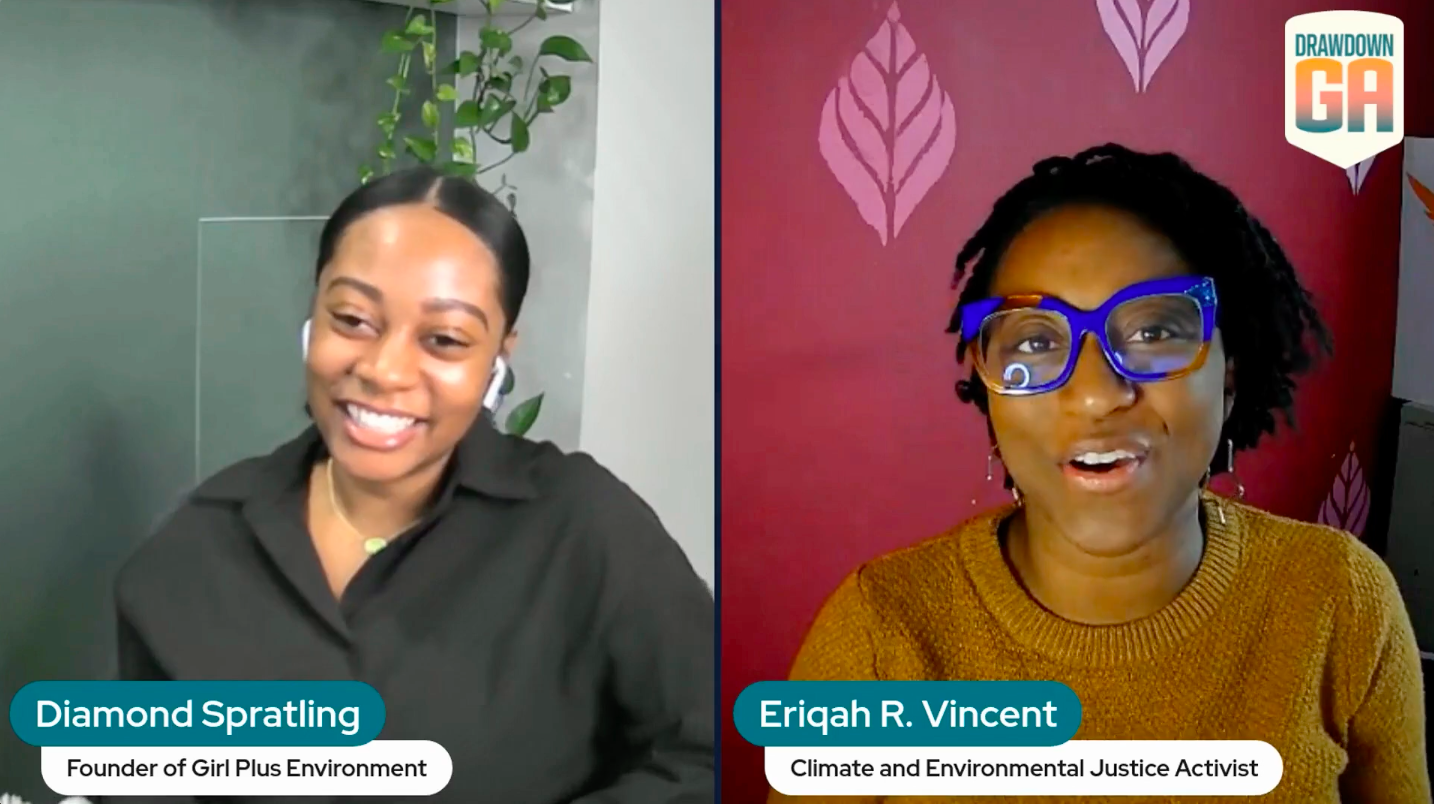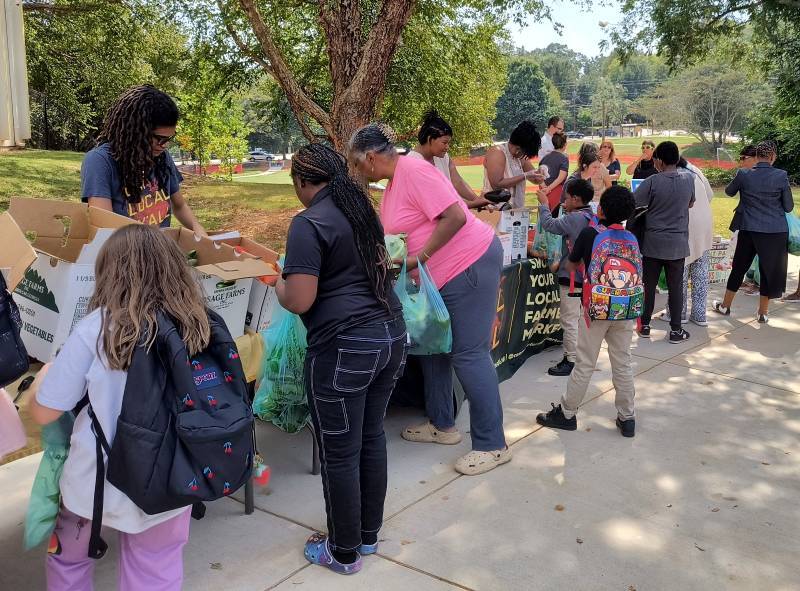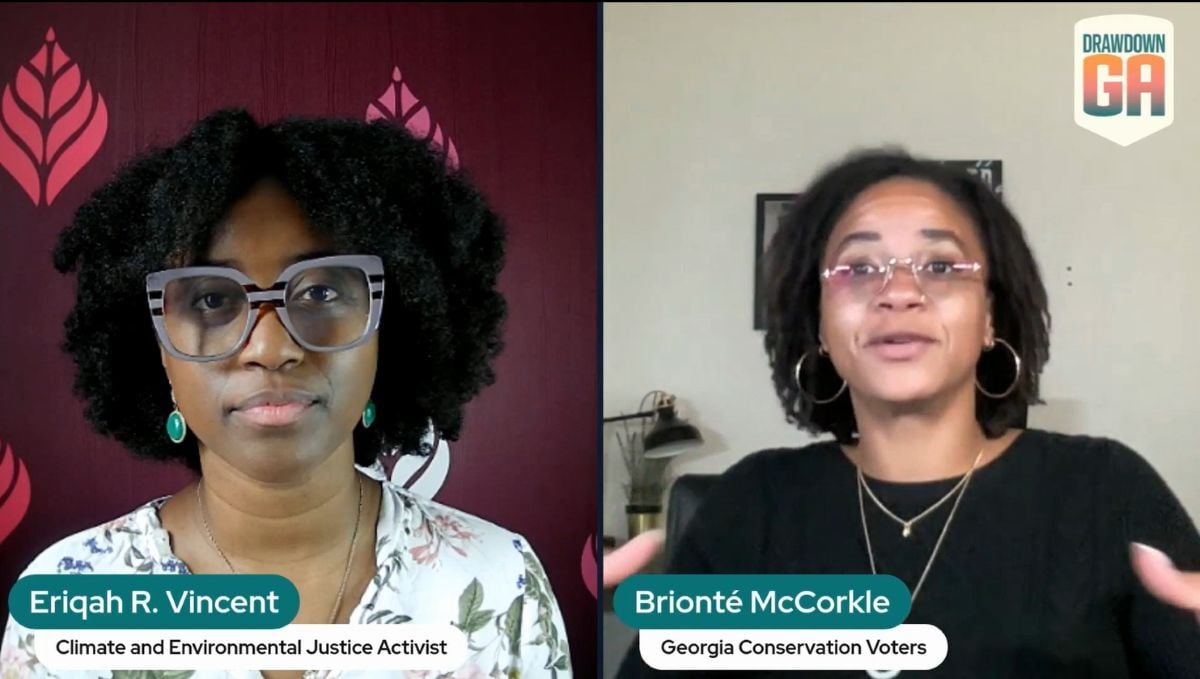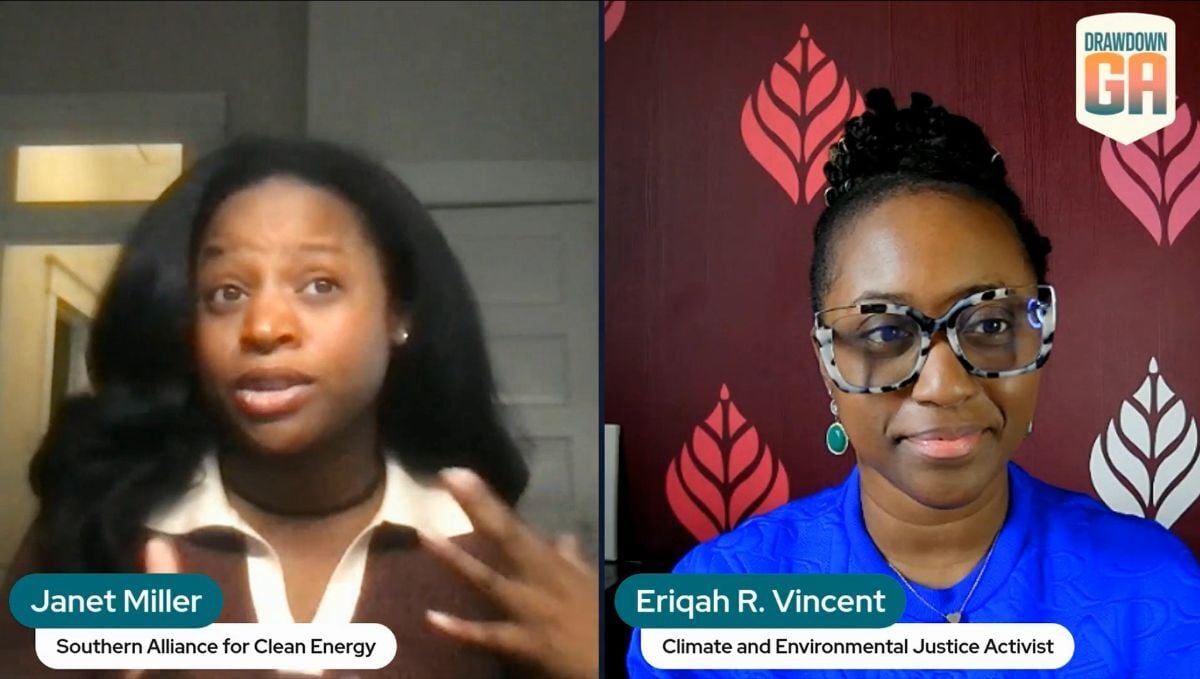How do we make climate conversations feel urgent—but not overwhelming?
For Diamond Spratling of Girl + Environment, the answer lies in culture, communication, and community. Her work is helping women of color claim their place in climate leadership across Georgia and beyond.
Watch the video above to hear more from Diamond in her conversation with Eriqah Vincent of Drawdown Georgia.
Keep reading to learn more about Diamond’s perspective on everything from communicating about climate to the importance of intergenerational connections and collaboration, and how Girl + Environment is empowering women of color to lead climate action in Georgia and beyond.
“It’s in our blood”: How Girl + Environment is Changing the Face of Climate Leadership
When Diamond Spratling launched Girl + Environment six years ago, she was responding to a deeply personal frustration: the disconnect between the environmental challenges impacting Black and Brown communities and the lack of representation in the spaces shaping solutions.
“I just remember being so upset learning about the relationship between our health, our public health, and the environment,” Diamond told Eriqah Vincent during a recent episode of *Drawdown Georgia Climate Digest*. “It wasn't that we didn’t care. It was that we weren’t having those conversations at the dinner table.”
Girl + Environment—a national nonprofit with strong Georgia roots—is dedicated to changing that reality. The organization empowers women of color to lead in environmental and climate justice, using community-rooted programs and culturally relevant communication to drive awareness, action, and access.
From Childhood Curiosity to Climate Justice Champion
Diamond’s journey toward a career focused on climate and the environment began in childhood on the west side of Detroit, where she spent every possible moment outdoors. That early connection to the natural world sparked a passion that followed her through college, her Master of Public Health degree program at Emory University, and her career in health and environmental policy.
But something was missing. “I noticed very early on that there weren’t many people who looked like me in the rooms, in the spaces, in the classrooms,” she said. “I wondered, where are the people who look like me? Why am I not seeing a space that feels inclusive?”
The turning point came during an internship focused on the intersection of environment and health. Discovering how environmental issues were harming Black and Brown communities—without their knowledge or consent—fueled her desire to take action. When her first attempts to raise awareness were met with silence, she realized a different approach was needed. “It wasn't that people didn’t care. They just weren’t being talked to in a way that made the issues feel real and urgent.”
Making Climate Conversations Relevant—and Relatable
What sets Girl + Environment apart is its culturally grounded, community-first approach. “We use social media to talk about the intersections between climate issues and things that resonate with our audience—like beauty products, periods, and hair care,” Diamond explained. “We meet people where they are.”
With more than 500 members—most of them in Georgia—the organization helps women of color take action through events, programs, and training. Whether it’s learning how to submit a public comment, talk to a representative, or host a community education event, Girl + Environment makes climate action accessible.
Programs range from technical assistance for community-led clean energy initiatives to workforce development and even training hairdressers as community health advocates. Each effort is rooted in a simple but powerful idea: climate leadership should reflect the people most impacted.
“We haven’t been given those opportunities,” Diamond said. “In fact, we’ve been pushed out. So when we think about our engagement, it’s critical that we not only bring ourselves into these spaces but create safe spaces for us to take ownership.”
Gen Z, Intergenerational Power, and the Future of Climate Solutions
Diamond sees Generation Z as a powerful force in the climate space—not just for their passion, but for their ability to activate. “Gen Z understands that climate is something that is non-negotiable,” she said. “They know it’s going to take everyone, and they know how to take action—especially from a grassroots level.”
But she also emphasized the importance of intergenerational dialogue. “We need more conversations between older generations and Gen Z,” she said. “Some things need improvement, and Gen Z brings a great opportunity to build on what our predecessors put together.”
Shifting the Narrative—and Who Tells It
For Diamond, making climate and equity conversations more mainstream starts with rethinking the message—and the messenger. “We’re tired,” she said about communities of color. “There’s always something else we have to do. Climate communication has to feel urgent—but also relatable, not overwhelming.”
Health is one of the most powerful entry points. As a public health professional, Diamond has seen firsthand how talking about asthma, heart disease, and environmental toxins resonates far more than abstract talk about carbon or ecosystems.
She also advocates for meeting people in spaces they already trust—from beauty salons to Black media to church events. “Why aren’t we working with BET, the Essence Festival, or mainstream cultural influencers?” she asked. “It’s time to normalize climate conversations in every space.”
Advice for Getting Involved—Especially in Georgia
Georgia, Diamond believes, is uniquely positioned to lead the clean energy transition. “Since the Inflation Reduction Act was implemented, we’ve seen over 300 clean energy projects in Georgia alone,” she said. “We are a state of entrepreneurs. That gives us so much opportunity.”
For those looking to get involved, she encouraged visiting the Girl + Environment website to find events, volunteer opportunities, and programs happening across the state—not just in Atlanta. “We’re launching work in Savannah and other coastal communities too,” she said.
A Movement Rooted in Hope and Resilience
When asked what gives her hope about climate action in Georgia, Diamond didn’t hesitate. “The community,” she said. “The grassroots leadership. The number of people coming together. It’s so resilient.”
She believes this moment calls for building “durable power”—community strength that lasts through political shifts, funding cycles, and changing headlines. “People ask me, ‘Are you worried?’ No, I’m hopeful,” she said. “Because we’ve got ourselves together on the ground.”
Stay Inspired - Subscribe to the Georgia Climate Digest for Future Interviews
Don’t miss out on future Georgia Climate Digest video interviews! Subscribe now to the Georgia Climate Digest to receive future Georgia Climate Digest video interviews right in your inbox, along with updates about our state’s progress on climate solutions. Click the button below to subscribe.









